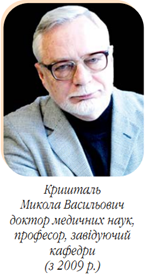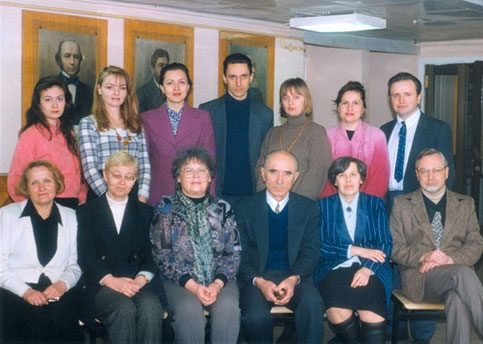Department of pathophysiology
History
As per the University Articles of Association of 1842, the first in Russian Empire Morbid Pathology Department with Pathology Anatomy was founded in Kyiv in 1845.
It was headed in 1841-1853 – by M.I.Kozlov – the pupil of M.I.Pirogov; 1854-1869 – famous pathologist and practitioner Yu.I.Matson.

In 1869, as per the University Articles of Association of 1863, the Department of General Pathology was founded. Its first professor and head as recommended by R.Virkhov was Nikanor Adamovych Hrjonschevsky, graduate from Kazan Univeristy, A.P. of Hygiene and General pathology Course, founder of Histology, Embriology and Comparative Anatomy Department of the Kharkiv University. He was famous due to his experimental scientific researches with use of vital stains physiological injections method highly praised by his scientific tutor – Rudolf Virkhov.
Due to this method, there was solved a disputable issue on presence of epithelium in air cells, conducted fundamental study of microscopic structure of the normal and pathological kidneys, liver, lien, lymph tubes. One of the most important N.A. Hrjonschevsky works is ‘About vasomotor nerves’.
In spite of intensive scientific histology activities – he developed physiology and pathology as he called himself as pathophysiologust.

He was the dean of the medical faculty (1870-1872), the president of the Kyiv Union of physicians (he founded first Kyiv free hospital at this union); head of commission of public lectures.
In 1888 the department of the Kyiv University was led by the graduate from the Medical Faculty of the Kyiv University Volodymyr Pidvysotskyi (1857-1913), who is considered to be the founder of the Ukrainian school of pathophysiologists. His pupils: Academicians D.K. Zabolotny and O.O.Bohomolets (presidents of the Academy of Sciences of Ukraine), professors: I.G. Savchenko, L.O. Tarasevich, S.M. Schastnyi, O.F. Mankivskyi.
During Kyiv period V.V. Pidvysotskyi became famous scientist, talented teacher and prominent public person. He was the first to prepare and publish in Ukraine one of the best manuals ‘General and Experimental Pathology’ (Kyiv, 1891). This book was recognized in Russia and in the whole world. It was translated in French, German, Greek and Japanese. During two years in Kyiv and seven years in Odesa he managed to do a lot. His scientific interests were very large. He completed studies in regeneration of the liver, the kidneys, and the spinal glands. He initiated the problems of infectious pathology, epidemiology, body reaction, immunity, endocrinology, etc.. which are included in the curriculums.
The issue of tumors etiology and their etiology initiated at the Medical Faculty of the Novorosiysk University in Odesa, chaired by V.V.Pidvysotskyi in 1900 is still urgent and in the Institute of Experimental medicine in Petersburg, director of which he was appointed (1905-1913 рр.). His Odesa period is remarked by construction of wonderful architecture complex of premises of a new medical faculty. He founded medical magazine ‘Russian archive of pathology, clinical medicine and bacteriology’ and newspaper ‘Russian Physician’.

In 1900 – 1922, the Department was chaired by the representative of the Moscow School of Pathophysiologists, pupil of professor O.B. Fohta – Prof. Volodymyr Lindeman. He was famous by his works on embolia of pulmonary artery and development in I.Mechnikov laboratory of the experimental model of cytotoxic glomerulonephritis.
Since 1910, V.Lindeman was simultaneously the head of the Department and the Director of the Kyiv Bacteriologic Institute (now L.V.Gromashevsky Scientific Research Institute of Epidemiology and Infectious Diseases of the Ministry of Health of Ukraine). At the beginning of the World War I he organized and chaired the activities of the Commission on chemical defense (then – Sanitary Chemical Institute, now – Institute of Pharmacology and Toxicology of the Academy of Sciences of Ukraine).
In 1910 – 1911, Professor V. Lindeman published ‘Guide on General Pathology, monograph ‘Heridity and changeability as disease reason’. His most famous pupils were Professors: S.Tymofeyev, V.Vinogradov, S.Chernyakhivsky, M.Vashetko, A.Krontovskyi, P.Kucherenko, I.Zavyalov, etc.

Then, the Department was chaired by Lindeman’s’ pupil, graduate from the St. Volodymyr University (1908) – MykolaVashetko. While working the physician of the clinical judicial section of the Kyiv Military Hospital, he simultaneously completed scientific and research activities under control of V.Lindeman. During the World War I he was a military doctor, actively participated in foundation of the Ukrainian medical organizations, was secretary of the commission on training of the First All-Ukrainian Meeting of Physicians.
Since 1918, he worked in the Kyiv Medical Institute as Professor of the General Pathology Department (Morbid physiology). Since 1922 – head of the Morbid physiology Department, in 1920 – 1924 he chaired the Pharmacology Department.
M.Vashetko continued to learn the problems of pathophysiology of urinoexcretory system.

In 1931 the department was chaired by Evhen Tatarinov who worked simultaneously in the Institute of Experimental Biology and Pathology (director – academician O.O. Bohomolets).
The close contact with teacher defined the character of the fruitful scientific activities of the department.
The materials of scientific works of the Department are used by Professor E. Tatarinov during writing the sections ‘Cell and tissue pathology’, ‘Immunity Studies’, ‘Blood pathology’ of three volumes of guide on morbid physiology edited by O.O. Bohomolets in 1933 and 1940. In 1939 E.Tatarinov was elected as corresponding member of the Academy of Sciences of the Ukrainian SSR.
During the Great Patriotic War, Prof. E.Tatarinov participated in the study of pathogenesis ‘hemorrhagic edematous erythema’.

Professor E.Tatarinov led the Medical Council and the Ukrainian Association of Pathologists, was the Dean of the Medical Faculty, and chaired the Science Section of the Kyiv Medical Institute. He was a man of culture, diplomatic and honest person.
After death of Professor of E.Tatarinov in 1950 the head of the department was Academician of the Academy of Sciences of the Ukrainian SSR Vasyl Komisarenko – a pupil of O.O. Bohomolets, specialist in endocrinology and metabolism, head of section of the O.O.Bohomolets Physiology Institute of the Academy of Sciences of the Ukrainian SSR. The Department continued to develop traditional activities: immunity and allergy, reaction and oncogenesis. Some employers worked in changes of nitrogen, carbohydrate, energy metabolism and other types of metabolism in case of defect of nervous and endocrine regulation. In 1965 V.Komisarenko founded the Scientific Research Institute of Endocrinology and Metabolism in Kyiv. The Institute became one of the main endocrinology centers of the Soviet Union.
He is the authors of over 300 scientific works, including 10 monographs; he trained 25 MD and 45 Ph.D. He was awarded with Lenin Order, Order of October Revolution, two Orders of Labor Red Flag, Order of Peoples Friendship, Order of Merit.
In 1955, another pupil of O.O.Bohomolets, Professor Mykola Syrotynin, Academician of the Academy of Medical Sciences of the USSR and Corresponding Member of the Academy of Sciences of the Ukrainian SSR, Doctor of Medical and Biological Sciences, became the Department Head. He was well-educated scientist who studied a lot of issues of medicine and biology.
In 1957 the department staff published ‘Methodological recommendations for practical classes in morbid physiology’ edited by M.Syrotynin.


Scientific activities were realized in hypothermia, hypoxia, immunity and allergy, endocrine pathology, cosmic physiology. M.Syrotynin edited in 1959 monothematic book “Issues of Hypothermia in Pathology”.
Professor M.Syrotynin with his pupils conducted studies of different aspects of hypoxia problem in high lands (vicinity of the Mt. Elbrus). For the cycle of works on the problem of hypoxia the authors led by M.Syrotynin (postmortem) received the State Award of Ukraine in Science and Techniques in 2000.
In 1960 Prof. Mykola Zayka became the Department Head – graduate from the Moscow Medical Institute who had chaired Odesa Department of Pathology Physiology before.
For 57 years of scientific and pedagogic activities Prof. M.Zayka taught 36 Ph.D. and 23 MD. His main scientific activity – problem of nervous trophism, neurogenic dystrophy and permeability of vessel wall. For the works cycle Corresponding Member of the Academy of Medical Sciences of the USSR, Professor M.Zayka received the O.O.Bohomolets Award.
M.Zayka edited in 1977 the third in the department history guide on morbid physiology; the authors received the Laureate of the State Award of the Ukrainian SSR.
The Department has been organizing the annual scientific lectures dedicated to Academician O.O.Bohomolets since 1974 as initiated by Professor M.Zayka.
In 1986 – 2008 the Department was chaired by Professor Yuriy Byts, a pupil of M.Zayka, graduate from the Kyiv Medical Institute.

In his doctoral thesis he formulated ‘power shortage’ concept of pathogenesis of Menkeberg’s arteriosclerosis, developed experimental model. The pupils of Professor Yu.Byts wrote and successfully defended 1 doctoral thesis and 7 Ph.D. theses. Their materials form the basis of the monograph ‘Comparative pathophysic aspects of power supply to vessel wall’ (1999).
In 1995 the authors republished the book ‘Pathophysiology’ n Ukrainian edited by M.Zayka, in1996 – in Russian.
In 2001 ‘Manual for practical classes in morbid physiology’ was published, in 2008 – second edition of manual ‘Pathophysiology’.

Yu.Byts was the head of the 2nd Medical Faculty, head of the Central Scientific Research Laboratory, Dean of the Faculty of Faculty of Teachers’ Advanced Training, Corresponding Member of the Academy of Pedagogic Sciences of Ukraine, Merited Worker of Education.
Since 2009, Professor Mykola Kryshtal – graduate and teacher of Chernivtsy Medical Institute, then Senior Scientific Specialist of the L.Gromashevsky Kyiv Scientific Research Institute of Epidemiology and Infectious Diseases.
In 1994 he was elected as A.P. of the Morbid physiology Department of the Bogomolets National Medical University.
In 1995 he defended the doctoral thesis ‘Neuro-homoral regulation of kidneys compensator reactions in case of metabolic acidosis’. Main scientific activities – research of nervous and endocrine regulation of kidneys and endocrine glands, study of pathogenesis of dysfunction of kidneys and vessels, water-electrolyte and acid-base state of organism, research of influence of acidosis on kidneys functions and protein and carbohydrate metabolism. He is the author of over 150 scientific and pedagogic works, including co-author of 2 manuals and 2 handbooks on morbid physiology.
In 2009-2010, the Department prepared and published new typical curriculums on morbid physiology for all the faculties.
New editions of ‘Morbid Physiology’ are published in Ukrainian, English and Russian.
In 2013 a new handbook for students’ independent work in morbid physiology edited by Prof. M.Kryshtal will be published. The fourth edition of the basic manual ‘Morbid physiology’ edited by Prof. M,Kryshtal is prepared for publication.
From 2018 Professor Panova Tatiana Ivanivna – a graduate of Donetsk State University became the head of the department.
In 1994, Tatiana Ivanivna, defended her PhD thesis on the theme: “The role of structures of the limbic-mesencephalic cat brain complex in the systematic organization of noci- and antinociceptive reactions of the organism”.
In 2009, Tatiana Ivanovna defended her doctoral dissertation on the topic: “Neurophysiological mechanisms and systemic manifestations of modulation of opioid reception (experimental study)”. Main directions of scientific activity: neurophysiological mechanisms of development and inhibition of craving for addictive substances (alcohol, opioids).
Scientific adviser of the state budget fundamental SRW 0119U101219 “Study of cell-molecular mechanisms of pharmacological influence on the reprogramming of the functional phenotype of macrophages in the regeneration of the wound against the background of hyperglycemia”.
Responsible executor of applied research SRW 0118U001214 “Study of the value of genetic factors and external influences in the development and progression of microcirculatory complications in type 2 diabetes”. She is the author of more than 250 publications, 5 textbooks, 30 manuals, 6 inventions and rational suggestions.
During the period of Professor Panova’s management, the department developed 7 manuals for pathological physiology for students of all specialties, in three languages (Ukrainian, Russian and English).
The Morbid Physiology Department of the National Medical University is approved by the Ministry of Health of Ukraine as basic. It participates in implementation of new teaching methods of morbid physiology in the academic activities, O.O.Bohomolets scientific lectures are also given.

Department staff in 1999



